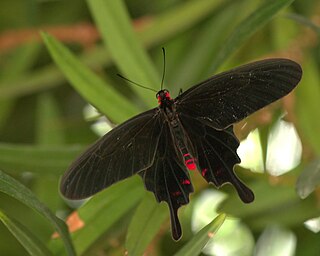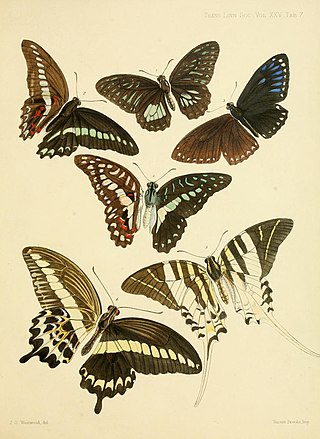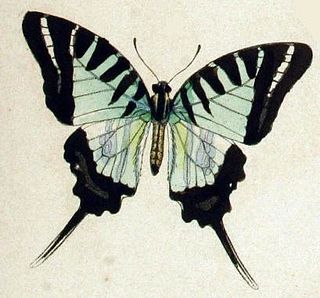
The osmeterium is a defensive organ found in all papilionid larvae, in all stages. The organ is situated in the prothoracic segment and can be everted when the larva feels threatened. The everted organ resembles a fleshy forked tongue, and this along with the large eye-like spots on the body might be used to startle birds and small reptiles. The osmeterial organ remains inside the body in the thoracic region in an inverted position and is everted when the larva is disturbed in any way emitting a foul, disagreeable odor which serves to repel ants, small spiders and mantids. To humans, this odour is rather strong but not unpleasant, usually smelling like a concentrated scent of the caterpillar's food plant and pineapple.

Pachliopta aristolochiae, the common rose, is a species of swallowtail butterfly belonging to the genus Pachliopta, the roses, or red-bodied swallowtails. It is a common butterfly which is extensively distributed across south and southeast Asia.

Graphium doson, the common jay, is a black, tropical papilionid (swallowtail) butterfly with pale blue semi-transparent central wing bands that are formed by large spots. There is a marginal series of smaller spots. The underside of wings is brown with markings similar to upperside but whitish in colour. The sexes look alike. The species was first described by father and son entomologists Cajetan and Rudolf Felder.

Atrophaneura pandiyana, the Malabar rose or pandiyana's maculaturoviy machaon with white stripes, is a swallowtail butterfly belonging to the genus Pachliopta, the roses or red-bodied swallowtails.

Red-bodied swallowtails, or ruby swallowtail (due to the color), are butterflies in the swallowtail family, that belong to the genera Atrophaneura, Byasa, Losaria, or Pachliopta. They are generally found in Asia.
Atrophaneura luchti is a species of butterfly in the family Papilionidae. It is endemic to Indonesia (Java).

Pachliopta kotzebuea, the pink rose, is a butterfly of the family Papilionidae. It is found in the Philippines.

Papilio hipponous is a butterfly of the family Papilionidae. It is found in the Philippines.

Pachliopta mariae is a species of butterfly from the family Papilionidae that is found in the Philippines.

Pachliopta phlegon is a species of butterfly from the family Papilionidae that is found in the Philippines.

Pachliopta strandi is a species of butterfly from the family Papilionidae that is found in the Philippines.

Graphium anthedon is a butterfly of the family Papilionidae, that is found in the Sunda Islands in the Malay Archipelago.

Graphium monticolus, the Sulawesi blue triangle, is a butterfly of the family Papilionidae that is found in Sulawesi in Indonesia.

Graphium euphrates is a butterfly found in the Philippines and Sulawesi that belongs to the swallowtail family.
Pachliopta adamas is a swallowtail butterfly belonging to the genus Pachliopta, the roses, or red-bodied swallowtails. It is found in Bawan, Java, and Enggano.

Graphium stratocles is a species of butterfly in the family Papilionidae. It is found in the Philippines.














